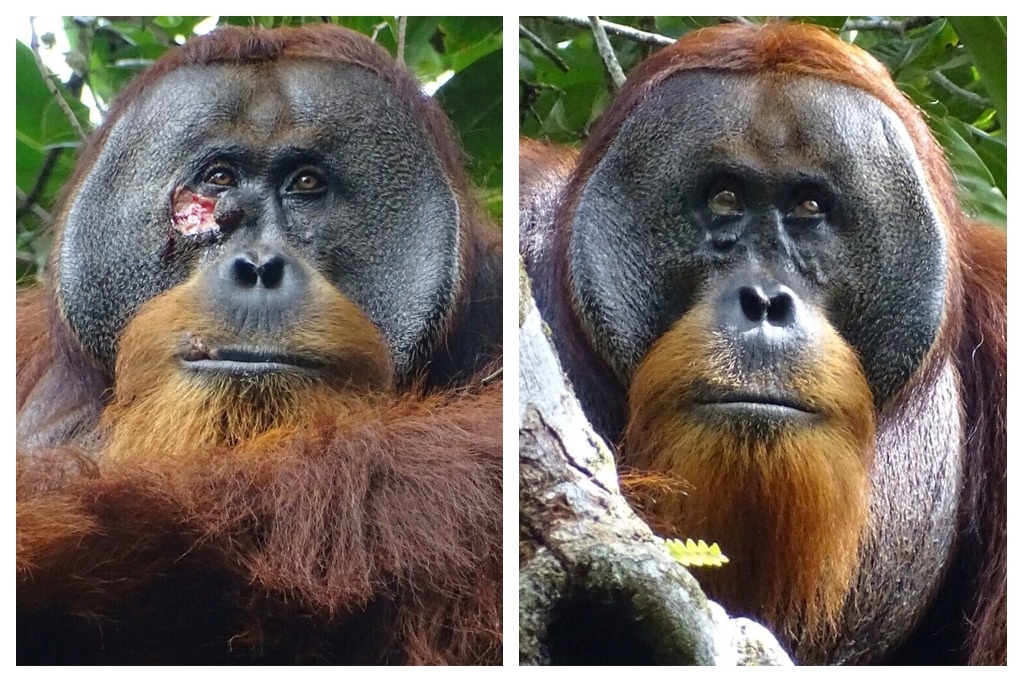In June 2022, a male Sumatran orangutan named Rakus suffered a facial injury below his right eye, reportedly during a fight with another male orangutan at the Suaq Balimbing Research Center, a protected area of rainforest in Indonesia.
What Rakus did three days later really caught the attention of scientists.
Researchers described this Thursday how Rakus seemed to heal the wound with a plant known for its analgesic and healing properties thanks to its antibacterial, anti-inflammatory, antifungal and antioxidant properties.
According to primatologist and cognitive biologist Isabelle Laumer of the Max Planck Institute for Animal Behavior in Germany, the orangutan chewed the leaves of the plant to produce a liquid that Rakus repeatedly smeared on the wound and then applied the chewed plant material directly to the lesion. , much like medical plasters.
Rakus also ate the plant, a perennial vine commonly called Akar Kuning -scientific name Fibraurea tincture– added Laumer, lead author of the study published in the journal Scientific Reports. This plant is rarely eaten by orangutans in this area of peat swamp forests, home to about 150 critically endangered Sumatran orangutans.
“To our knowledge, this is the first documented case of active wound treatment with a plant species with medicinal properties by a wild animal,” said the study’s lead author, Caroline Schuppli, an evolutionary biologist at the institute.
Rakus, believed to have been born in 1989, is a bridled male, with large cheek pads on either side of the face, male secondary sexual characteristics. Rakus was one of the dominant males in the area.
The researchers said the orangutan’s self-treatment of the wound did not seem coincidental.
“His behavior seemed intentional. He selectively treated the facial wound on his right bridle with the juice of the plant, and no other part of the body. The behavior was repeated several times, not only did he apply plant juice, but later also more solid plant material, until the wound was completely covered. The whole process took a considerable time,” explains Laumer.
The wound never showed signs of infection and closed within five days, according to researchers.
“The observation suggests that the cognitive abilities necessary for this behavior – the active treatment of wounds with plants – may be as old as the last common ancestor of orangutans and humans,” Schuppli said.
“However, what exactly these cognitive abilities are remains to be investigated. Although this observation demonstrates that orangutans are capable of treating their wounds with plants, we do not know to what extent they understand the process.”
The last common ancestor of orangutans and humans lived about 13 million years ago.
Orangutans are one of the world’s great apes – the closest living relatives of humans – along with chimpanzees, bonobos and gorillas. Orangutans are the least related to humans, but they share about 97 percent of our DNA.
“It is possible that treatment of wounds with Fibraurea tincture emerges through accidental individual innovation. It is possible for individuals to accidentally touch wounds while feeding. Fibraurea tincture and inadvertently apply the juice of the plant to their wounds,” Laumer said.
“But it may also be,” Laumer added, “that Rakus learned this behavior from other orangutans in his birth area.”
Widely distributed throughout China, Indonesia, Malaysia, Thailand, Vietnam and other parts of Southeast Asia, this plant is used in traditional medicine to treat conditions such as malaria.
Orangutan means “forest person” in the Indonesian and Malay languages, and these apes are the largest arboreal mammal in the world. Orangutans, adapted to living in trees, lead a more solitary life than other great apes, sleeping and eating fruit in the treetops and swinging from branch to branch.
“Orangutans have great cognitive abilities, especially in the area of physical cognition,” explains Schuppli.
“They are known to be excellent problem solvers. Wild orangutans acquire their skills through observational social learning, and these are passed down from generation to generation. The population where this observation was made is known for its rich cultural repertoire, which includes use of tools in different contexts”.
#Orangutan #medicinal #plant #heal #wound #intrigues #scientists
– 2024-05-03 22:55:45


